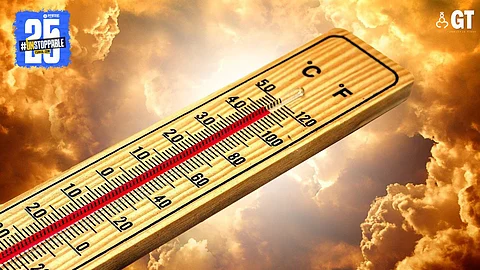

In Goa, we have become quite familiar with yellow, orange and red alerts during the monsoon, with the Meteorological Department issuing these warnings of heavy rains in the days ahead. At times the alerts have been spot on, at others maybe not so correct, but then we do know that the weather is unpredictable and so we let it go.
On the other hand, yellow alerts warning of high temperatures in the summer are rare, so rare that it is difficult to remember any such alerts in the past years. But 2025 seems to be different.
In early March, a yellow alert warning of above average temperatures was issued for three days, and extended twice. At the time of writing, the alert still stands and has been going for seven straight days.
In Goa, yellow alerts warning of high temperatures in the summer are rare, so rare that it is difficult to remember any such alerts in the past years. But 2025 seems to be different.
This time, almost everybody who has been in Goa in the past days, whether a resident or a traveller, will agree that the days just gone by have been unexceptionally hot, which would mean that the Meteorological Department has been right.
That, for the present, is not debatable. It’s been hot, and the humidity is high. If you check the weather online, it shows the temperature along with what it actually feels like, which, at times, is two to three degrees higher.
We are in the early weeks of the Goan summer. As the days advance and temperatures increase, which they doubtless will as April and May are the torrid summer months in Goa, we are certain to experience a hot summer this year, perhaps hotter than past ones, but rather than predict, we can wait to ascertain it.
We are in the early weeks of the Goan summer. As the days advance and temperatures increase, we are certain to experience a hot summer this year
Higher temperatures are not a phenomenon restricted to Goa or this region; they are being experienced worldwide. Early in January, we learnt from the World Meteorological Organisation (WMO) that 2024 was the warmest year on record, with the past ten years have all ranking in the top ten,
The WMO described this as an extraordinary streak of record-breaking temperatures. It led the UN Secretary-General António Guterres to say, “Today’s assessment from the World Meteorological Organisation (WMO) proves yet again – global heating is a cold, hard fact.”
Against the background of almost regular updates of the previous year being the hottest in record, or the frequent news of temperatures in a particular month being the highest recorded in past few years, it stands to reason that the temperatures in Goa would follow the trend. And yet, what is Goa doing about this ‘cold hard fact’ of rising temperatures?
Goa cannot ignore climate change and what it is doing to the region. There has been heavy rainfall and seasons that have received more than normal rainfall.
Goa cannot ignore climate change and what it is doing to the region. What the State has experienced in past years in relation to weather changes are many and varied. There has been heavy rainfall and seasons that have received more than normal rainfall.
There have been rain showers every month of the year, which is not normal for Goa. The heavy rainfall and the unusual pattern has led to flooding on low-lying areas, resulting in damage to crops and in some cases even loosening of the soil.
On the other hand, rising temperatures can impact the flowering of cashew and mango trees, besides others, leading to a lower production for a season, and Goa has experienced this already, even if not in a major manner.
In effect, the rise in temperatures, the unusual pattern of rainfall, the cyclones in the Arabian Sea, individually and collectively, do pose threats to Goa. The cyclones in particular that rarely developed on the west coast are now increasing and will have a direct impact on the coastal areas of the State.
On the other hand, rising temperatures can impact the flowering of cashew and mango trees, besides others, leading to a lower production for a season
Another contributing factor to the Goa weather changes is the unrestricted development and changes in land usage. The clearing of wooded areas, the filling of land in agricultural areas, the construction in urban and rural areas have a direct link to the increase in temperatures.
Goa has to play a role, a much larger one, in combating climate change and merely plans on paper or posturing will not do. What is required is action on the ground that will reverse, or at the very least, offset some of the changes that are taking place.
The rising temperatures and unusual rainfall pattern are nature’s reactions to the changes taking place across the world – the rise in greenhouse gasses. Unless these are reduced, the climate pattern will not reverse to its normal, and that reversal can only happen through governmental intervention.